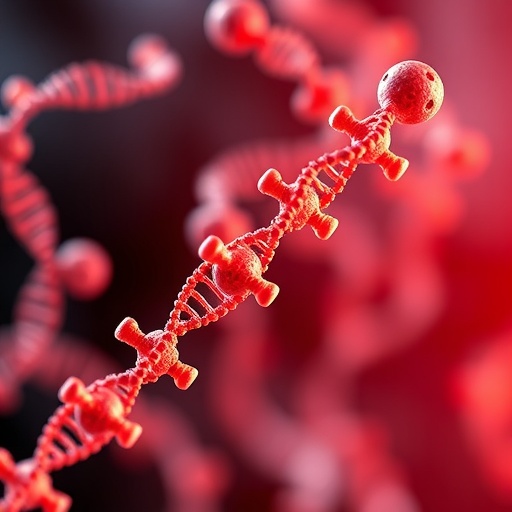
In the rapidly evolving landscape of RNA therapeutics, a significant hurdle has been the unintended inflammatory responses elicited by lipid nanoparticles (LNPs). These microscopic fat-based delivery vehicles have become indispensable for the transport of genetic materials such as messenger RNA (mRNA) into target cells, enabling groundbreaking treatments ranging from gene therapy to vaccines. However, despite their clinical successes, LNP-induced inflammation poses a serious challenge, especially in the context of treating diseases where immune activation could exacerbate patient outcomes. Recent pioneering research from the Perelman School of Medicine at the University of Pennsylvania has unveiled two ingenious methods to mitigate this inflammation without compromising the efficiency of RNA delivery, potentially opening new frontiers for RNA therapeutics in inflammatory and acute conditions.
LNPs rely on cellular endosomes to ferry RNA cargo into the cell interior, where the payload can then function effectively, for instance, by instructing cells to produce therapeutic proteins. Endosomes are membrane-bound compartments that traffic molecules entering the cell. However, as the RNA payload escapes from the endosome into the cytoplasm, the membrane often ruptures, creating transient breaches. These ruptures inadvertently release cellular factors that activate innate immune sensors, sparking inflammation. Central to this immune detection are galectins, a family of carbohydrate-binding proteins that recognize damaged endosomal membranes and initiate signaling cascades culminating in inflammatory responses.
The breakthrough from the Pennsylvania team centers on the modification of the LNP construct itself and the strategic use of an anti-inflammatory agent. The first innovation involves the incorporation of a specialized biodegradable lipid, named 4A3-SC8, into the nanoparticle formulation. This unique lipid modulates the extent of endosomal membrane disruption—causing smaller, more manageable perforations that the cell can rapidly repair. The result is a significant reduction in the release of inflammatory danger signals, allowing the RNA molecules to enter the cytosol effectively while minimizing the collateral immune activation that plagues conventional LNPs.
.adsslot_s9KXmrcCjq{width:728px !important;height:90px !important;}
@media(max-width:1199px){ .adsslot_s9KXmrcCjq{width:468px !important;height:60px !important;}
}
@media(max-width:767px){ .adsslot_s9KXmrcCjq{width:320px !important;height:50px !important;}
}
ADVERTISEMENT
Parallel to the lipid modification approach, researchers identified the potential of thiodigalactoside (TG), a relatively accessible, albeit uncommon, small-molecule drug as a potent molecular shield. TG functions by blocking the activity of galectins, thereby inhibiting the downstream inflammatory signaling triggered by endosomal rupture. When TG is co-formulated with LNPs, it acts as a pharmacological brake on inflammation, neutralizing one of the key pathways responsible for immune system activation following RNA delivery. This pharmacological tandem strategy uniquely complements the structural innovation of the lipid formulation.
The real-world implications of these discoveries were put to rigorous test in a preclinical model of acute respiratory distress syndrome (ARDS), a severe inflammatory lung condition characterized by fluid infiltration and impaired oxygen exchange. ARDS is a critical illness with limited therapeutic options and high mortality rates, partly due to the deleterious effects of excessive inflammation. By applying either of the novel LNP strategies—4A3-SC8-enhanced lipids or TG co-delivery—the researchers successfully administered mRNA therapeutics that significantly attenuated lung inflammation and tissue damage. Importantly, these modified LNPs circumvented the usual inflammatory side effects that have historically curtailed the therapeutic window of RNA-based treatments in such disease states.
Dr. Jacob Brenner, MD, PhD, a key investigator in the study and assistant professor at the Perelman School of Medicine, emphasized the transformative potential of this work. He explained that by engineering LNPs to be less damaging and incorporating inflammation-blocking mechanisms, they are expanding the possibilities of RNA therapeutics to treat a host of critical conditions—including heart attacks, strokes, and inflammatory lung diseases—where inflammation is both a cause and consequence of tissue injury.
This research also provides an important clarification regarding LNP usage in vaccines, such as those for COVID-19. Conventional vaccine formulations deliberately exploit LNPs’ immune-stimulating properties to enhance immunogenicity. Dr. Brenner noted that “vaccines rely on LNPs to stimulate the immune system throughout the body, which is key to their success.” However, for therapeutic applications targeting diseased organs vulnerable to inflammation, such widespread immune activation is counterproductive. Hence, the need for refined LNP platforms that are immunologically stealthy yet efficacious.
More broadly, these findings represent a critical advancement in the maturation of RNA therapeutic delivery vehicles. The burgeoning field of RNA medicine has witnessed remarkable strides, from cancer immunotherapies to genetic disorder correction. Nonetheless, effective and safe delivery remains a bottleneck. The innovative approach of combining molecular engineering of lipid components with targeted inhibition of immune sensors addresses this bottleneck head-on, proposing a blueprint for safer delivery systems adaptable to diverse clinical contexts.
Serena Omo-Lamai, the study’s first author and a PhD candidate, highlighted the versatility and safety improvements ushered in by these methods. According to Omo-Lamai, these dual strategies promise to broaden RNA treatment applicability, particularly for inflammatory diseases that were previously deemed too risky to approach with RNA-based drugs, marking a pivotal opportunity to push the boundaries of modern molecular medicine.
The study’s rigorous support from major funding bodies—including the American Heart Association and multiple branches of the National Institutes of Health—reflects the broad recognition of the urgent unmet need for safer RNA delivery platforms. Furthermore, the University of Pennsylvania’s legacy as a pioneer in biomedical innovation underpins the significance of translating these scientific insights from bench to bedside.
In sum, this pioneering work shines light on the intricate interplay between delivery materials and host immune defenses in RNA therapeutics. By mitigating endosomal damage and intercepting inflammation signaling, these novel LNP formulations promise to redefine the safety profile of RNA medicines. As RNA-based therapies continue to surge forward, such innovations will be indispensable in realizing their full therapeutic potential across an expanding spectrum of diseases characterized by inflammation and cellular stress.
Subject of Research: Lipid nanoparticle-mediated RNA delivery and inflammation reduction
Article Title: [Not specified in the provided content]
News Publication Date: [Not specified in the provided content]
Web References: https://www.nature.com/articles/s41565-025-01974-5
References: [Not specified in the provided content]
Image Credits: [Not specified in the provided content]
Keywords: Inflammatory response, Lipid nanoparticles, RNA delivery, Endosomal rupture, Galectins, Thiodigalactoside, Acute respiratory distress syndrome, RNA therapeutics
Tags: advancements in RNA-based treatmentsendosomal escape mechanisms in RNA therapygalectins and immune activationimmune responses to lipid nanoparticlesinflammatory responses in gene therapiesinnovative methods for RNA therapy safetylipid nanoparticles in gene therapymitigating inflammation in RNA deliveryovercoming challenges in RNA drug deliveryRNA therapeutics for inflammatory diseasessafety improvements in RNA therapeuticstherapeutic applications of messenger RNA





